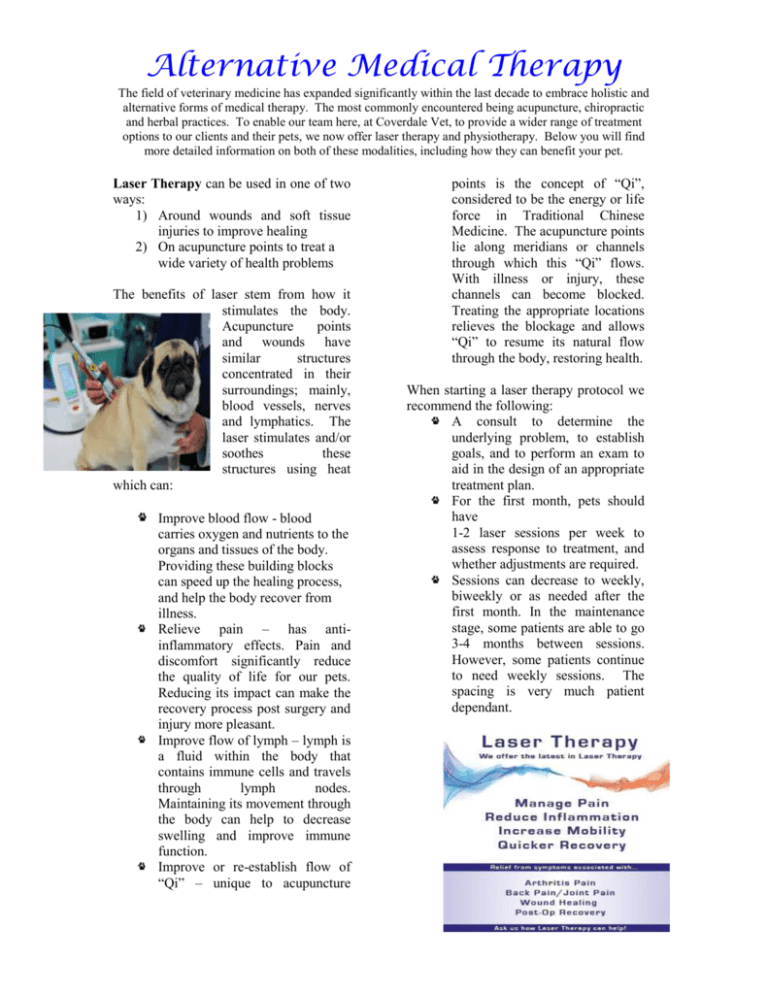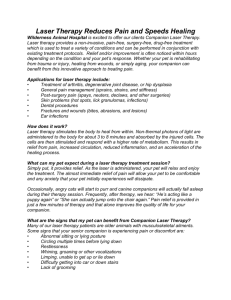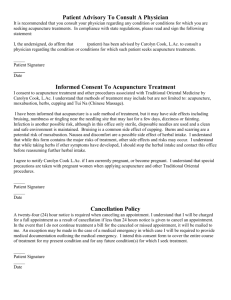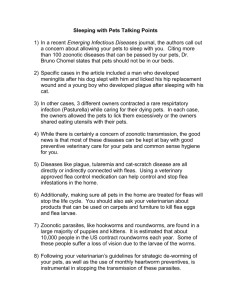To - Coverdale Vet
advertisement

Alternative Medical Therapy The field of veterinary medicine has expanded significantly within the last decade to embrace holistic and alternative forms of medical therapy. The most commonly encountered being acupuncture, chiropractic and herbal practices. To enable our team here, at Coverdale Vet, to provide a wider range of treatment options to our clients and their pets, we now offer laser therapy and physiotherapy. Below you will find more detailed information on both of these modalities, including how they can benefit your pet. Laser Therapy can be used in one of two ways: 1) Around wounds and soft tissue injuries to improve healing 2) On acupuncture points to treat a wide variety of health problems The benefits of laser stem from how it stimulates the body. Acupuncture points and wounds have similar structures concentrated in their surroundings; mainly, blood vessels, nerves and lymphatics. The laser stimulates and/or soothes these structures using heat which can: Improve blood flow - blood carries oxygen and nutrients to the organs and tissues of the body. Providing these building blocks can speed up the healing process, and help the body recover from illness. Relieve pain – has antiinflammatory effects. Pain and discomfort significantly reduce the quality of life for our pets. Reducing its impact can make the recovery process post surgery and injury more pleasant. Improve flow of lymph – lymph is a fluid within the body that contains immune cells and travels through lymph nodes. Maintaining its movement through the body can help to decrease swelling and improve immune function. Improve or re-establish flow of “Qi” – unique to acupuncture points is the concept of “Qi”, considered to be the energy or life force in Traditional Chinese Medicine. The acupuncture points lie along meridians or channels through which this “Qi” flows. With illness or injury, these channels can become blocked. Treating the appropriate locations relieves the blockage and allows “Qi” to resume its natural flow through the body, restoring health. When starting a laser therapy protocol we recommend the following: A consult to determine the underlying problem, to establish goals, and to perform an exam to aid in the design of an appropriate treatment plan. For the first month, pets should have 1-2 laser sessions per week to assess response to treatment, and whether adjustments are required. Sessions can decrease to weekly, biweekly or as needed after the first month. In the maintenance stage, some patients are able to go 3-4 months between sessions. However, some patients continue to need weekly sessions. The spacing is very much patient dependant. Alternative Medical Therapy The field of veterinary medicine has expanded significantly within the last decade to embrace holistic and alternative forms of medical therapy. The most commonly encountered being acupuncture, chiropractic and herbal practices. To enable our team here, at Coverdale Vet, to provide a wider range of treatment options to our clients and their pets, we now offer laser therapy and physiotherapy. Below you will find more detailed information on both of these modalities, including how they can benefit your pet. In physiotherapy, the motto = use it or lose it. Exercises are designed to keep joints and muscles moving. It is primarily effective as part of a rehabilitation plan following surgery or injury (especially orthopedic or neurologic), or as part of an osteoarthritis treatment plan. The benefits include: Supporting joint health – joints are dependent on the fluid within their capsules for nutrition. When pets stop moving and using joints, the movement of this fluid is decreased, and joint surfaces do not receive the nutrition they need, leading to decreased cartilage health. Strengthening muscle mass – with disuse, muscle decrease in size and strength. Joints depend on muscle for support. Keeping muscles healthy and fit, can help boost mobility longterm. Re-learning muscle memory – especially important with neurologic issues such as disc disease. When the line of communication between the brain and the rest of the body gets disrupted it can lead to weakness and instability. Repetitive exercises can help the body relearn proper positioning for limbs and retrain the muscles. Improve comfort – massage is useful prior to exercises to help warm up and prepare the muscles. Massage also improves blood flow and is soothing for the pet. Combined together, these benefits can significantly increase mobility and quality of life for pets. The appropriate exercises and stretches can be taught to owners for treatment at home. Keys to physiotherapy: Do not push a stretch or exercise. Go only as far as is comfortable for your pet. Repetition is your friend. Typically recommend reps of 1015 up to three times daily. Do not work cold muscles. Either massage beforehand, or plan on doing exercises following walks.






